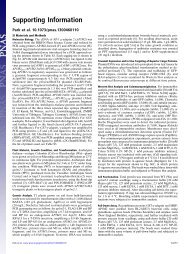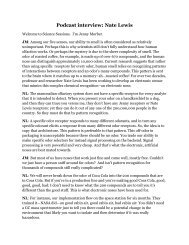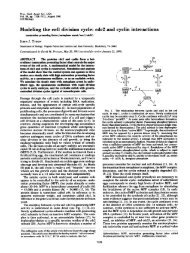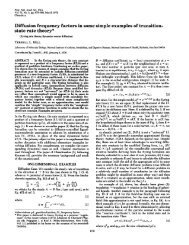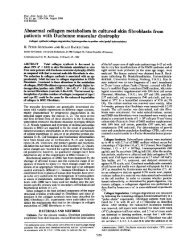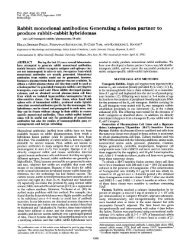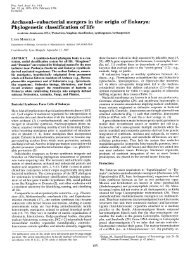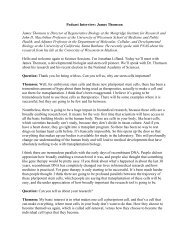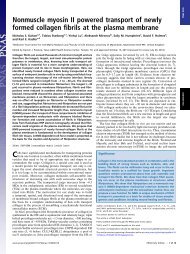Juvenile hormone and its receptor, methoprene- tolerant, control the ...
Juvenile hormone and its receptor, methoprene- tolerant, control the ...
Juvenile hormone and its receptor, methoprene- tolerant, control the ...
You also want an ePaper? Increase the reach of your titles
YUMPU automatically turns print PDFs into web optimized ePapers that Google loves.
with that from 0–6 h PE using a minimum fold change of ≥1.75<br />
(0.8 in a log2 scale) as <strong>the</strong> confidence threshold <strong>and</strong> a false-discovery<br />
rate (P value) of ≤0.01, because it has been used previously<br />
(28). There was an unexpectedly high increase of gene expression<br />
activity during <strong>the</strong> PE developmental stage in <strong>the</strong> fat body of female<br />
Aedes mosquitoes (Fig. 1A <strong>and</strong> Dataset S1). The number of<br />
DEGs increased dramatically over this PE time period, reaching<br />
a maximum at 60–66 h PE, with 6,146 genes being ei<strong>the</strong>r up- or<br />
down-regulated (Fig. 1A).<br />
To analyze <strong>the</strong> gene-expression dynamics during PE development,<br />
we performed hierarchical clustering of <strong>the</strong> DEGs<br />
identified in <strong>the</strong> previous step (Fig. 1B). Partitioning of <strong>the</strong><br />
resulting gene dendrogram identified 11 clusters. Three major<br />
clusters with expression trends relevant for fat-body PE development<br />
were identified: early posteclosion (EPE), mid posteclosion<br />
(MPE), <strong>and</strong> late posteclosion (LPE) (Fig. 1 B <strong>and</strong> C <strong>and</strong><br />
Dataset S1). The 1,843 genes of <strong>the</strong> EPE cluster (clusters 1 <strong>and</strong> 4)<br />
have <strong>the</strong> highest expression around 0–6 h PE, followed by a<br />
gradual decline throughout PE development (Fig. 1C). The MPE<br />
cluster (cluster 10) contained 457 genes. Their expression levels<br />
peaked at 18–24 h PE <strong>and</strong> declined <strong>the</strong>reafter. The LPE cluster<br />
(cluster 2) included 1,815 genes; transcript levels of <strong>the</strong>se genes<br />
were low at 0–6 h PE, rose throughout PE to reach peak expression<br />
at 60–66 h, <strong>and</strong> declined moderately at 72–78 h PE (Fig.<br />
1C <strong>and</strong> Dataset S1). Quantitative RT-PCR (qPCR) analysis of<br />
selected EPE, MPE, <strong>and</strong> LPE genes showed correlation with<br />
microarray data (Fig. S1 <strong>and</strong> Dataset S2).<br />
Overall, our data suggest that EPE genes are maximally<br />
expressed at a low JH titer <strong>and</strong> MPE genes are maximally<br />
expressed at an intermediate JH level; expression levels within<br />
both of <strong>the</strong>se gene groups is inhibited at a high JH titer. The<br />
expression of LPE genes, however, exhib<strong>its</strong> an opposite trend,<br />
requiring a high JH titer for <strong>the</strong>ir maximal expression.<br />
PE Gene Expression in <strong>the</strong> Fat Body of Female Mosquitoes Deprived of<br />
JH or Met. To establish fur<strong>the</strong>r that <strong>the</strong> JH signaling pathway is<br />
<strong>the</strong> major determinant of gene regulation in PE development, we<br />
used preparations of isolated mosquito abdomens deprived of<br />
JH. The specimens were prepared as described in Materials <strong>and</strong><br />
Methods. Total RNA was isolated 24 h after preparing JHdeprived<br />
mosquitoes, <strong>and</strong> transcript levels were measured by<br />
qPCR for seven EPE <strong>and</strong> nine LPE genes (Dataset S2). Transcript<br />
levels of tested EPE genes increased in <strong>the</strong> JH-deprived mosquitoes<br />
with <strong>the</strong> topical application of solvent in <strong>the</strong> absence of JH<br />
but were inhibited after JH was topically applied (Fig. 2A, Fig. S2A<br />
<strong>and</strong> Dataset S2). In contrast, LPE genes showed an opposite<br />
trend; <strong>the</strong>ir transcript levels were suppressed in <strong>the</strong> absence of JH<br />
<strong>and</strong> were elevated with <strong>the</strong> application of <strong>the</strong> <strong>hormone</strong> (Fig. 2B,<br />
Fig. S2B <strong>and</strong> Dataset S2). Thus, we confirmed that JH has an<br />
inhibitory effect on a subset of <strong>the</strong> EPE gene cluster <strong>and</strong> an activating<br />
effect on a subset of <strong>the</strong> LPE gene cluster.<br />
To test whe<strong>the</strong>r <strong>the</strong>se JH gene regulation patterns were mediated<br />
by Met, we performed in vitro fat-body culture experiments.<br />
In preparation for <strong>the</strong> Met RNAi experiments, we<br />
conducted preliminary tests to evaluate <strong>the</strong> effectiveness of <strong>the</strong><br />
Met RNAi (iMet) knockdown (Dataset S2). At 6 h PE female<br />
mosquitoes were injected with ei<strong>the</strong>r Met dsRNA or with luciferase<br />
(Luc) dsRNA as a <strong>control</strong>, <strong>and</strong> <strong>the</strong> Met transcript level <strong>and</strong><br />
ovarian follicle growth were examined 72 h postinjection. Mosquitoes<br />
with Met RNAi depletion also exhibited retardation of<br />
ovarian follicle growth, similar to that of female mosquitoes<br />
deprived of JH, reported earlier (Fig. S3 A <strong>and</strong> B) (9, 10).<br />
Compared with <strong>the</strong> iLuc <strong>control</strong>, <strong>the</strong> Met transcript levels, visualized<br />
using RT-PCR, was very low in <strong>the</strong> female mosquito fat<br />
body after <strong>the</strong> injection of Met dsRNA (Fig. S3C).<br />
Fat bodies from Met dsRNA- <strong>and</strong> Luc dsRNA-injected mosquitoes<br />
were incubated in a complete culture medium supplemented<br />
with ei<strong>the</strong>r JH or solvent (acetone) for 8 h. The same set<br />
of genes as for JH-deprived mosquitoes was analyzed by means<br />
of qPCR (Fig. 2 C <strong>and</strong> D <strong>and</strong> Fig. S2 C <strong>and</strong> D). In fat bodies<br />
from iLuc <strong>control</strong> mosquitoes, <strong>the</strong>se genes showed a significant<br />
response to <strong>the</strong> presence of JH in <strong>the</strong> culture medium; transcript<br />
levels of selected EPE genes decreased (Fig. 2C <strong>and</strong> Fig. S2C)<br />
<strong>and</strong> those of LPE genes were elevated (Fig. 2D <strong>and</strong> Fig. S2D),<br />
correlating with <strong>the</strong> effect of JH application on <strong>the</strong>se genes in<br />
JH-deprived mosquitoes. Transcript levels of <strong>the</strong> same EPE<br />
genes were elevated <strong>and</strong> those of LPE genes were down-regulated<br />
in fat bodies of Met-depleted mosquitoes incubated with<br />
solvent only, in a fashion similar to that in JH-deprived mosquitoes<br />
treated with solvent (Fig. 2 C <strong>and</strong> D <strong>and</strong> Fig. S2 C <strong>and</strong> D).<br />
No change was observed in transcript levels of ei<strong>the</strong>r EPE or LPE<br />
genes in fat bodies of Met-depleted mosquitoes incubated in <strong>the</strong><br />
presence of JH as compared with those incubated in solvent only<br />
(Fig. 2 C <strong>and</strong> D <strong>and</strong> Fig. S2 C <strong>and</strong> D).<br />
Effect of Met RNAi Depletion on <strong>the</strong> Fat-Body Transcriptome in Aedes<br />
Female Mosquitoes PE. Met RNAi depletion was conducted as<br />
described above, <strong>and</strong> fat-body RNA was isolated from both Met<br />
dsRNA-injected <strong>and</strong> Luc dsRNA-injected (<strong>control</strong>) mosquitoes<br />
at 72 h postinjection <strong>and</strong> was subjected to microarray analysis.<br />
Transcripts with differential expression of ≥1.75 folds (0.8 in<br />
a log2 scale) <strong>and</strong> a false-discovery rate (P value) of ≤0.01 were<br />
selected for fur<strong>the</strong>r examination. An impressively large number<br />
of genes were affected by iMet. In total, 1,385 genes were upregulated<br />
<strong>and</strong> 1,169 were down-regulated in <strong>the</strong> iMet transcriptome<br />
(Dataset S3). The qPCR analysis of 11 selected genes<br />
(seven down-regulated <strong>and</strong> four up-regulated) from iMet-depleted<br />
fat bodies demonstrated levels of <strong>the</strong>se transcripts similar<br />
to those from <strong>the</strong> iMet microarray transcriptome, confirming <strong>the</strong><br />
validity of <strong>the</strong> latter screen (Fig. S3 D <strong>and</strong> E).<br />
Comparison of <strong>the</strong> fat-body transcriptome from Met-depleted<br />
mosquitoes with that of <strong>the</strong> PE developmental time course<br />
revealed that iMet resulted in up-regulation of 491 (27%) <strong>and</strong><br />
181 (40%) of EPE <strong>and</strong> MPE genes, respectively (Fig. 3 A <strong>and</strong> B<br />
<strong>and</strong> Dataset S4) The two-tailed P values of



